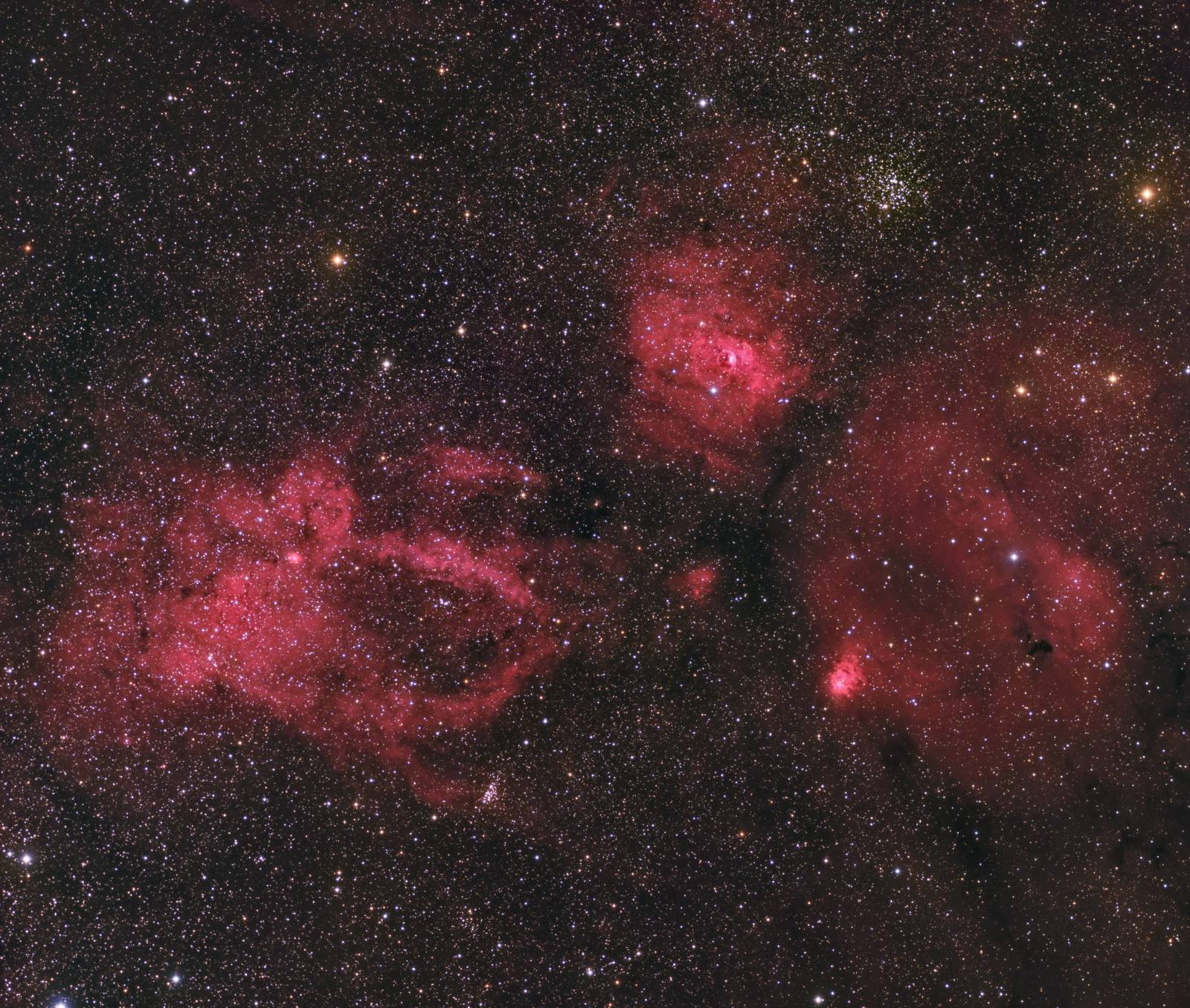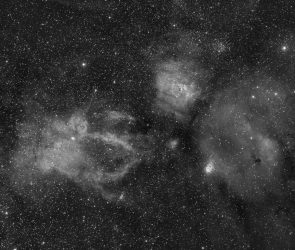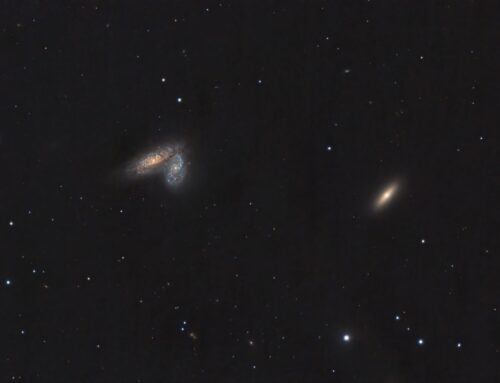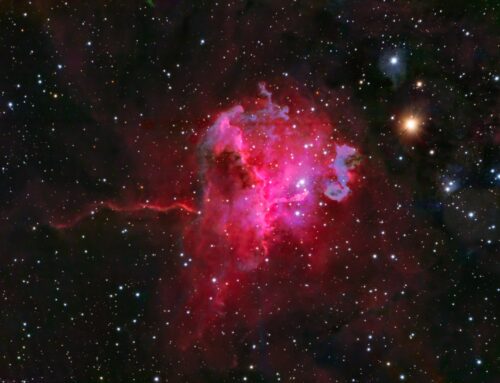Bubble Nebula Region – Wide Field
 Click image for full size version
Click image for full size version
September 4, 2017
This image shows a wide field view of the region around the Bubble Nebula in Cassiopeia. I’ve imaged the Bubble Nebula a few times. It inhabits a very busy patch of sky. Several other deep sky objects show up nicely in this image, and are also shown in an annotated image of this region:
- The Bubble Nebula (NGC 7635) is the most famous object in this image, just above and right of centre. The Bubble is surrounded by Sh2-162, a billowy, textured cloud of glowing hydrogen gas. Both are between 7,000-11,000 light years away.
- The open cluster M52 sparkles to the upper right of the Bubble, and is located 5,000 light years away. It is one of my favourite small telescope open clusters.
- Sh2-161 is at lower right, also around 9,100 light years from us. NGC 7538 (a.k.a. Sh2-158) is the bright patch along the bottom edge of Sh2-161.
- The large Sh2-157, the Lobster Nebula, is left of centre. Just beneath the lobster’s “claw” is open cluster NGC 7510.
- Almost dead centre in this image is Herbig-Haro 170 (also known as MWC1080). It is the small orangish patch of nebula and surrounds a very young star. Herbig-Haro objects are associated with newly born stars, and form when gas ejected by the stars collides at high speed with surrounding clouds of gas and dust.
- Sh2-159 is a small patch of nebulae lying below the Bubble in this image.
 The objects that dominate this image are made up of clouds of hydrogen atoms that release energy as red light. I prepared a black and white version that uses only this H-alpha wavelength. It shows more subtle brightness differences and smaller stars. Click on the thumbnail to see it full size.
The objects that dominate this image are made up of clouds of hydrogen atoms that release energy as red light. I prepared a black and white version that uses only this H-alpha wavelength. It shows more subtle brightness differences and smaller stars. Click on the thumbnail to see it full size.
Tekkies:
Moravian G3-16200 EC camera (on loan from O’Telescope), Optolong Ha, R, G and B filters, Takahashi FSQ-106 ED IV at f/3.6, Paramount MX, unguided. Acquisition with the SkyX, focused with FocusMax, scripted with CCD Commander. All pre-processing and processing in PixInsight. Acquired from my SkyShed in Guelph. Moderate moonlight for Ha, no moonlight for RGB, average transparency and seeing.
28x5m R and G, 24x5m B and 34x10m Ha unbinned frames (total=12hr20m).
NB-RGB Creation:
Creation and cleanup: The BatchPreProcessing script was used to perform calibration, cosmetic correction and registration of all frames. LocalNormalization, ImageIntegration and DrizzleIntegration were used to make the Ha, R, G and B masters. The masters were cropped to remove edge artifacts. R, G and B were combined to make an RGB image which was processed with DBE, BackgroundNeutralization and ColorCalibration.
Combining Ha and RGB data: The NBRGBCombination script was run with default settings using Ha for red narrowband. PhotometricColorCalibration was applied.
Linear Noise Reduction: MultiscaleLinearTransform was used to reduce noise in the NB-RGB image. Layer settings for threshold and strength: Layer 1: 3.0 0.8 Layer 2: 2.5, 0.7 Layer 3: 2., 0.6 Layer 4: 1.0, 0.2 Layer 5: 0.5, 0.1.
Stretching: HistogramTransformation was applied to the NB-RGB image to make a pleasing, bright image.
Synthetic Luminance:
Creation and cleanup of SynthL: The Ha master was used as the SynthL.
Deconvolution: A star mask was made to use as a local deringing support image. A copy of the image was stretched to use as a range mask. Deconvolution was applied (50 iterations, regularized Richardson-Lucy, external PSF made using DynamicPSF tool with about 30 stars).
Linear Noise Reduction: MultiscaleLinearTransform was used to reduce noise in the background areas of the NB-RGB file. Layer settings for threshold and strength: Layer 1: 3.0 0.8 Layer 2: 2.5, 0.6 Layer 3: 2., 0.5 Layer 4: 1.0, 0.2.
Stretching: HistogramTransformation was applied to the SynthL to make a pleasing, bright image.
Dynamic Range Adjustment: HDRMultiscaleTransform was applied at scales of 6 and 4 pixels using a mask to protect stars and background.
Noise Reduction and Re-Stretch: TGVDenoise was applied in Lab mode with 300 iterations with a range mask applied to protect high signal areas. This was followed by a HistogramTransformation to raise the black point (but with no clipping).
Local Contrast Adjustment: Areas of the image that had been processed with HDRMultiscaleTransform were processed with two passes of LocalHistrogramEqualization with max contrast of 1.5 (scale 50, strength 0.45 and scale 150, strength 0.18) using a mask to protect background and stars.
Combining SynthL with NB-RGB:
The processed SynthL was applied to the NB-RGB image using LRGBCombine.
Additional Processing:
Final Steps: MultiscaleLinearTransform was used to sharpen the structures in the bright parts of the nebulae (layers 2-4 at 0.035). Background, nebula and star brightness, contrast and saturation were adjusted in several iterations using Curves with masks as required. A range mask was used to protect background and stars while adjusting the hue of the nebula to reduce a slight orange cast. Stars were reduced in size using the MorphologicalTransformation tool’s morphological selection mode using a star mask to limit the tool’s effect to large and medium sized stars. The DarkStructureEnhance script was used to increase contrast between dark nebula and brighter regions, followed by a final contrast and saturation adjustment.
Image scale is about 1.6 arcsec per pixel for this camera/telescope combination and Drizzle processing.






Awesome work Ron and thanks for so much detail on your processing, it is helping me enormously! 🙂